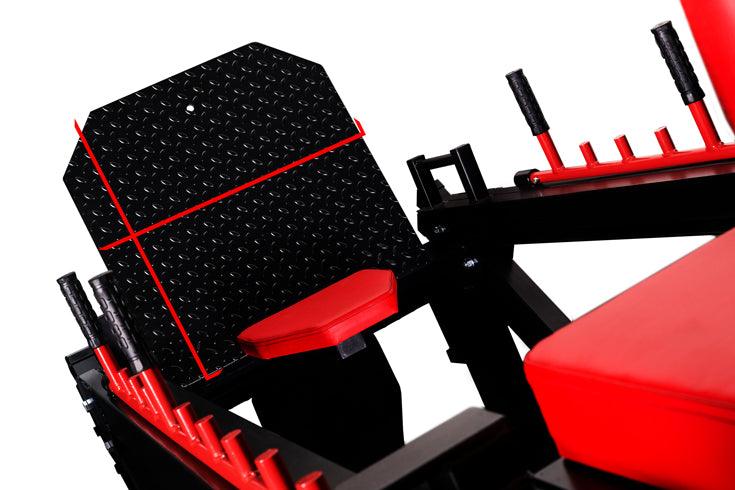The Best Hack Squat Workout: Techniques and Variations for Strength
Introduction to Hack Squats and Their Place in Strength Training
The hack squat stands as one of the most effective compound movements for developing lower body strength and muscle mass, offering unique advantages that distinguish it from traditional barbell squats while providing exceptional stimulus for leg development. This exercise, performed primarily on a specialized hack squat machine, allows for heavy loading with reduced spinal compression, making it an invaluable tool for athletes, bodybuilders, and fitness enthusiasts seeking to maximize lower body strength gains while minimizing injury risk.
The biomechanics of the hack squat create a movement pattern that emphasizes quadriceps development while still engaging the glutes, hamstrings, and calves in a coordinated effort that builds functional strength applicable to athletic performance and daily activities. The fixed path of motion provided by the machine ensures consistent form while allowing users to focus entirely on generating force and achieving progressive overload without the balance and stability challenges inherent in free weight squatting.
Understanding the hack squat's role within a comprehensive strength training program requires recognizing its unique benefits compared to other lower body exercises. While traditional squats remain the king of compound movements, hack squats offer specific advantages including reduced lower back stress, enhanced quadriceps isolation, and the ability to safely train to failure without requiring a spotter, making them particularly valuable for solo training sessions.
The versatility of hack squat training extends beyond simple strength development to include applications in powerlifting accessory work, bodybuilding specialization phases, and rehabilitation settings where controlled movement patterns provide therapeutic benefits. This adaptability makes the hack squat an essential component of any serious lower body training protocol, whether used as a primary movement or supplemental exercise.
The progressive nature of hack squat training allows for systematic strength development through careful manipulation of training variables including load, volume, tempo, and range of motion. This systematic approach enables practitioners to achieve consistent gains while minimizing plateaus and maintaining long-term progress toward strength and physique goals.

Anatomy and Biomechanics of the Hack Squat
Primary Muscle Groups and Movement Patterns
The hack squat primarily targets the quadriceps muscle group, consisting of the vastus lateralis, vastus medialis, vastus intermedius, and rectus femoris, with the fixed angle of the movement creating particularly strong activation of these muscles throughout the entire range of motion. The machine's design allows for deep knee flexion while maintaining optimal loading patterns that maximize quadriceps development and strength gains.
The gluteus maximus and medius serve as secondary movers during the hack squat, providing hip extension force and lateral stability throughout the movement. The degree of glute activation can be modified through foot placement and stance width adjustments, allowing for targeted emphasis on either quadriceps or glute development within the same basic movement pattern.
Hamstring involvement occurs primarily as stabilizers and antagonists during the hack squat, with the biceps femoris, semitendinosus, and semimembranosus providing knee stability and assisting with controlled descent. While not the primary movers, the hamstrings contribute significantly to overall movement quality and force production throughout the range of motion.
The calves, particularly the gastrocnemius and soleus, activate to maintain ankle position and contribute to the kinetic chain during hack squat execution. This involvement helps develop lower leg strength and stability that transfers to other athletic movements and daily activities requiring lower body power and coordination.
Core musculature engagement during hack squats includes the erector spinae, transverse abdominis, and obliques, though to a lesser degree than free weight squats due to the back support provided by the machine. This reduced core demand allows for greater focus on leg development while still maintaining appropriate trunk stability and posture throughout the movement.
Joint Mechanics and Force Production
The hip joint operates primarily in the sagittal plane during hack squats, moving from flexion to extension while maintaining optimal positioning for force production. The machine's angled design allows for natural hip mechanics while reducing the forward lean typically required in free weight squats, creating a more vertical torso position that enhances quadriceps activation.
Knee joint mechanics during hack squats involve pure flexion and extension in the sagittal plane, with the machine's guided path ensuring consistent knee tracking and reducing the risk of valgus or varus deviation that can occur during free weight squatting. This controlled environment allows for maximum force production while minimizing joint stress and injury risk.
Ankle joint mobility plays a crucial role in hack squat depth and overall movement quality, with adequate dorsiflexion range of motion allowing for deeper squatting positions and enhanced muscle activation. Limited ankle mobility can be accommodated through foot positioning adjustments or heel elevation, making the exercise accessible to individuals with varying mobility levels.
The force vector during hack squats differs significantly from traditional squats due to the angled machine design, creating a more favorable loading pattern for quadriceps development while reducing shear forces on the spine. This unique force application allows for heavier loading with reduced injury risk, making it particularly valuable for strength development phases.
Leverage factors within the hack squat movement allow for mechanical advantages that enable heavier loading compared to many other quadriceps-focused exercises. The machine's design optimizes the length-tension relationships of the involved muscles while providing external support that enhances force production capabilities.

Hack Squat Machine Setup and Safety Considerations
Proper Machine Adjustment and Positioning
Shoulder pad positioning represents the foundation of proper hack squat setup, requiring adjustment to accommodate individual torso length while ensuring even pressure distribution across the upper trapezius and shoulder region. The pads should rest comfortably on the meaty portion of the shoulders without creating pressure points on the neck or spine, with sufficient padding to prevent discomfort during heavy loading.
Back pad angle adjustment determines the degree of trunk support and influences the movement pattern throughout the exercise. The optimal angle provides firm support while allowing natural spinal curvature, typically ranging from 45 to 60 degrees depending on machine design and individual biomechanics. Proper adjustment ensures maximum support without restricting natural movement patterns.
Foot platform positioning requires careful consideration of individual limb length and flexibility characteristics, with the platform height adjusted to allow full range of motion without compromising knee or ankle positioning. The platform should enable deep squatting while maintaining proper joint alignment throughout the movement pattern.
Safety stop mechanisms must be properly positioned to prevent excessive descent while allowing for full range of motion training. These stops should be set at a depth that maintains proper form while providing a safety net in case of strength failure or loss of control during heavy training sessions.
Machine stability and maintenance checks should be performed regularly to ensure safe operation during heavy loading. This includes verifying that all adjustment mechanisms lock securely, weight pins are properly seated, and the machine's rail system operates smoothly without binding or excessive play.
Safety Protocols and Risk Mitigation
Warm-up procedures for hack squat training should include general body temperature elevation followed by specific movement preparation that addresses the hip, knee, and ankle joints involved in the exercise. Progressive loading during warm-up sets allows for tissue preparation while identifying any mobility or stability issues that could affect performance or safety.
Loading progression strategies minimize injury risk while maximizing strength development, with gradual increases in training load allowing for tissue adaptation and technique refinement. Sudden load increases should be avoided in favor of systematic progression that respects individual recovery capacity and adaptation rates.
Spotting considerations for hack squat training differ from free weight exercises due to the machine's design, with safety stops serving as the primary safety mechanism rather than human spotters. However, training partners can assist with motivation and form monitoring, particularly during high-intensity training phases.
Range of motion limitations may be necessary for individuals with previous injuries or mobility restrictions, with partial range training providing benefits while respecting individual limitations. These modifications should be temporary when possible, with mobility work addressing underlying restrictions to enable full range training.
Emergency procedures should be established for training scenarios involving equipment failure or acute injury, with clear protocols for safely exiting the machine and accessing medical assistance when necessary. All users should be familiar with emergency stop mechanisms and proper dismounting procedures.
Fundamental Hack Squat Technique
Starting Position and Setup
The initial approach to the hack squat machine requires deliberate positioning that establishes proper alignment and stability throughout the movement. Begin by backing into the machine with feet positioned hip-width apart on the foot platform, ensuring even weight distribution across both feet while maintaining natural toe alignment that promotes optimal knee tracking.
Shoulder placement against the pads requires careful attention to positioning, with the pads resting on the upper trapezius muscles rather than the neck or spine. The shoulders should be pulled back and down to create a stable platform for force transmission while maintaining proper spinal alignment throughout the movement pattern.
Hand positioning on the machine's handles provides additional stability and control during the exercise, with a firm but relaxed grip that allows for natural movement while providing security during heavy loading. The handles should be grasped evenly to prevent rotational forces that could compromise form or safety.
Core engagement prior to movement initiation establishes intra-abdominal pressure that supports the spine and enhances force transmission throughout the kinetic chain. This bracing should be maintained throughout the movement while allowing for controlled breathing patterns that support performance and safety.
Initial unracking of the weight requires controlled movement that establishes proper starting position while maintaining stability and alignment. The weight should be smoothly lifted from the safety stops with legs extended but not locked out, creating a stable platform for the subsequent squatting movement.
Descent Phase Mechanics
The lowering phase of the hack squat begins with controlled hip and knee flexion that maintains proper joint alignment while gradually loading the target muscles. The descent should be initiated by pushing the hips back slightly while simultaneously bending the knees, creating a coordinated movement pattern that distributes forces appropriately across the involved joints.
Knee tracking during the descent must align with the toes to prevent valgus or varus deviation that could stress the knee joint structures. Proper tracking is facilitated by maintaining even pressure across both feet while engaging the glutes to control hip position throughout the range of motion.
Depth control during the hack squat should aim for maximum safe range of motion while respecting individual mobility limitations and maintaining proper form. Generally, descending until the knees reach approximately 90 degrees of flexion provides excellent stimulus while remaining within safe parameters for most individuals.
Tempo considerations during the descent phase typically involve a controlled 2-3 second lowering that allows for proper muscle activation while maintaining control throughout the range of motion. This controlled tempo enhances the eccentric training stimulus while improving movement quality and reducing injury risk.
Breathing patterns during the descent should involve controlled exhalation that maintains core stability while preventing excessive intra-abdominal pressure that could compromise circulation or cause dizziness. Proper breathing coordination supports performance while maintaining safety throughout the movement.
Ascent Phase Execution
The upward phase of the hack squat requires explosive concentric muscle action that drives the body back to the starting position through coordinated hip and knee extension. The movement should be initiated by driving through the heels while simultaneously extending the hips and knees in a smooth, powerful motion that maximizes force production.
Force application during the ascent should emphasize driving through the entire foot while maintaining proper weight distribution that prevents forward drift onto the toes. This full-foot contact ensures optimal force transmission while maintaining stability and proper joint alignment throughout the movement.
Hip and knee extension coordination prevents premature hip extension that could shift loading away from the quadriceps toward the glutes and hamstrings. Proper coordination maintains consistent quadriceps activation throughout the range of motion while ensuring balanced force production across all involved muscle groups.
Lockout completion requires full hip and knee extension without hyperextension that could stress joint structures unnecessarily. The top position should be held briefly to ensure complete muscle activation while preparing for the subsequent repetition or safe completion of the set.
Breathing coordination during the ascent typically involves forceful exhalation that supports core stability while facilitating maximum force production. This breathing pattern helps coordinate muscle activation while maintaining proper intra-abdominal pressure throughout the challenging portion of the movement.
Advanced Hack Squat Variations
Foot Position Modifications
High foot placement on the hack squat platform shifts emphasis toward the posterior chain muscles, particularly the glutes and hamstrings, while reducing quadriceps dominance typically seen in standard foot positioning. This variation requires placing the feet higher on the platform with heels positioned near the top edge, creating a movement pattern that more closely resembles a Romanian deadlift pattern.
Low foot placement emphasizes quadriceps development by increasing the knee flexion angle required to achieve depth while reducing hip flexion involvement. This positioning places the feet lower on the platform with heels positioned closer to the bottom edge, creating a more knee-dominant movement pattern that maximizes quadriceps activation and development.
Wide stance hack squats target the inner quadriceps and glutes more effectively while accommodating individuals with limited hip mobility or long torsos that make narrow stance squatting challenging. The wider foot position allows for greater hip external rotation while maintaining proper knee alignment throughout the movement pattern.
Narrow stance positioning emphasizes the outer quadriceps and requires greater hip and ankle mobility to achieve proper depth while maintaining form. This variation challenges stability and coordination while providing unique stimulus for muscle development and movement quality improvement.
Single-leg hack squats represent an advanced variation that challenges unilateral strength, stability, and coordination while identifying and addressing strength imbalances between legs. This variation requires excellent control and should only be attempted by experienced practitioners with well-developed bilateral hack squat technique.
Range of Motion Modifications
Partial range hack squats can be valuable for overloading specific portions of the movement while accommodating mobility limitations or working around injuries. These modifications include quarter squats that emphasize the lockout portion, half squats that work the middle range, and bottom-position partials that overload the deep squat position.
Pause hack squats incorporate deliberate stops at various points in the range of motion, typically at the bottom position, to eliminate elastic energy and require pure concentric strength to initiate the upward movement. These pauses can range from 1-5 seconds depending on training goals and experience level.
1.5 rep hack squats combine full range repetitions with partial repetitions to increase time under tension and training volume while emphasizing specific portions of the movement. These typically involve performing a full repetition followed by a partial repetition from the bottom to halfway up before completing another full repetition.
Deficit hack squats utilize platform modifications or elevated heel positions to increase the range of motion beyond what is typically possible with standard machine setup. This increased range provides enhanced muscle activation and flexibility development while challenging strength throughout extended movement patterns.
Pre-exhaust hack squats involve performing isolation exercises for the quadriceps immediately before hack squats to pre-fatigue the muscles and ensure maximal activation during the compound movement. This technique can enhance muscle development while improving mind-muscle connection and movement quality.
Tempo and Intensity Modifications
Slow eccentric hack squats emphasize the lowering portion of the movement with controlled descents lasting 4-6 seconds or longer, creating significant muscle damage and metabolic stress that promotes hypertrophy and strength development. This technique requires reduced loading to maintain proper form throughout the extended time under tension.
Explosive concentric hack squats focus on maximum speed during the upward phase while maintaining controlled descents, developing power and rate of force development that transfers to athletic performance. These require submaximal loading to allow for maximum acceleration throughout the movement.
Cluster set hack squats involve breaking traditional sets into smaller segments with brief rest periods between mini-sets, allowing for maintained intensity throughout higher volume training sessions. This approach enables heavier loading while accumulating significant training volume within single training sessions.
Rest-pause hack squats extend sets beyond normal failure points by incorporating brief rest periods that allow for additional repetitions with the same load. This technique maximizes muscle activation and metabolic stress while pushing training intensity beyond traditional parameters.
Drop set hack squats involve immediately reducing the load upon reaching failure and continuing with additional repetitions, creating extended time under tension and maximum muscle activation. This technique can be repeated multiple times within a single extended set for maximum training effect.
Programming Hack Squats for Strength Development
Periodization and Training Phases
Strength-focused programming for hack squats requires systematic manipulation of training variables over time to promote continuous adaptation while preventing stagnation and overtraining. Linear periodization models gradually increase intensity while decreasing volume over time, creating peak strength adaptations for specific goals or competitions.
Block periodization divides training into distinct phases with specific adaptations targeted during each block, such as hypertrophy, strength, and power phases that build upon each other to create comprehensive fitness development. Hack squats can serve different roles within each block based on the targeted adaptation.
Daily undulating periodization varies training stimuli within each week, with different intensities and volumes applied during different training sessions to promote varied adaptations while preventing staleness. This approach allows for frequent variation while maintaining systematic progression toward strength goals.
Conjugate periodization incorporates multiple training qualities simultaneously through varied exercises and intensities within the same training week, with hack squats serving as either maximum effort, dynamic effort, or repetition effort exercises depending on the specific training focus and weekly structure.
Autoregulation approaches adjust training variables based on daily readiness and performance indicators, allowing for individualized progression that respects recovery capacity and adaptation rates. This flexible approach optimizes training stress while minimizing the risk of overtraining and injury.
Volume and Intensity Guidelines
Beginning practitioners should start with moderate volumes and intensities that allow for technique mastery while promoting gradual strength development, typically involving 2-3 sets of 8-12 repetitions at 65-75% of one-repetition maximum. This conservative approach enables proper movement pattern development while minimizing injury risk.
Intermediate trainees can handle increased training volumes and intensities, with 3-4 sets of 6-10 repetitions at 75-85% of maximum representing appropriate progression from beginner parameters. This increased stimulus promotes continued strength development while maintaining sufficient volume for muscle growth.
Advanced athletes require higher intensities and varied approaches to continue progress, with training involving 4-6 sets of 3-8 repetitions at 80-95% of maximum providing the stimulus necessary for continued strength gains. This high-intensity approach requires excellent technique and adequate recovery between sessions.
Deload phases involving reduced volume and intensity should be incorporated every 4-6 weeks to promote recovery and prevent overtraining, with 50-70% reductions in training stress allowing for adaptation while maintaining movement patterns. These phases are crucial for long-term progress and injury prevention.
Volume landmarks for different training goals include 6-12 sets per week for strength maintenance, 12-18 sets for strength development, and 18-25 sets for maximum strength gains in experienced athletes. These ranges provide guidelines while requiring individualization based on recovery capacity and training response.
Integration with Other Exercises
Hack squats complement traditional barbell squats by providing similar movement patterns with reduced spinal loading, making them valuable for high-volume training phases or when managing lower back fatigue. The combination allows for increased training frequency while distributing stress across different movement patterns.
Pairing hack squats with hip-dominant exercises like Romanian deadlifts or hip thrusts creates balanced lower body development while addressing all major movement patterns. This combination ensures comprehensive strength development while preventing muscle imbalances that could lead to injury or performance limitations.
Upper body exercise integration should consider the systemic fatigue created by intense hack squat training, with upper body sessions scheduled to allow adequate recovery between high-intensity lower body sessions. This scheduling optimization maximizes training quality while preventing interference effects.
Accessory exercise selection should complement hack squat training by addressing movement limitations and muscle imbalances that could affect performance or increase injury risk. Examples include ankle mobility work, glute activation exercises, and core stabilization training that support optimal hack squat performance.
Competition preparation requires specific integration of hack squats within overall training programs, with the exercise serving as valuable accessory work for powerlifters or primary movement for bodybuilders depending on competitive goals and individual needs.
Common Mistakes and Troubleshooting
Technical Errors and Corrections
Forward knee drift represents one of the most common hack squat errors, occurring when the knees track inside the toes during the descent phase and creating potential for knee injury while reducing exercise effectiveness. This error typically results from weak glutes, poor foot positioning, or inadequate hip mobility, requiring targeted corrective strategies.
Correction strategies for knee valgus include strengthening the glutes through targeted exercises, improving hip mobility through specific stretching protocols, and practicing proper movement patterns with reduced loading. Cues such as "push the knees out" or "spread the floor with your feet" can help reinforce proper knee tracking during movement execution.
Incomplete range of motion limits the exercise's effectiveness while potentially creating strength imbalances at different joint angles. This limitation may result from mobility restrictions, fear of deep positions, or improper machine setup that prevents full depth achievement while maintaining proper form.
Addressing range of motion limitations requires systematic mobility work targeting the hips, knees, and ankles while gradually progressing depth as flexibility improves. Hip flexor stretching, ankle dorsiflexion mobility, and posterior chain flexibility all contribute to improved squatting depth and movement quality.
Weight distribution errors, such as shifting onto the toes or favoring one foot over the other, compromise movement efficiency while potentially creating injury risk through improper loading patterns. These errors often result from poor foot positioning, muscle imbalances, or inadequate focus on proper force application throughout the movement.
Equipment-Related Issues
Machine maintenance problems can significantly affect hack squat performance and safety, with issues such as sticky rails, worn pads, or loose adjustments creating suboptimal training conditions. Regular inspection and maintenance ensure optimal machine function while preventing equipment-related injuries or performance limitations.
Weight plate loading errors, including uneven loading or improper plate securing, can create dangerous training conditions while affecting movement quality through unbalanced resistance. Proper loading procedures and safety checks prevent these issues while ensuring consistent training stimulus.
Foot platform wear or damage can affect traction and stability during hack squat performance, with worn surfaces creating slip hazards while uneven wear patterns may indicate improper foot positioning or machine alignment issues. Regular platform inspection and replacement maintain optimal training conditions.
Shoulder pad adjustment problems can create discomfort or instability during heavy loading, with improper positioning causing pressure points or inadequate support that limits performance. Understanding proper adjustment procedures ensures optimal comfort and stability during training sessions.
Safety mechanism failures represent serious safety concerns that require immediate attention and equipment service, with issues such as malfunctioning safety stops or broken adjustment mechanisms creating significant injury risk. Regular safety system inspection and professional maintenance prevent these dangerous situations.
Programming and Recovery Issues
Overtraining symptoms specific to hack squat training include persistent knee discomfort, reduced force production, and movement quality degradation that indicates excessive training stress relative to recovery capacity. Recognition of these symptoms enables appropriate training modifications before more serious issues develop.
Recovery inadequacy between hack squat sessions can manifest as persistent muscle soreness, reduced performance, or increased injury susceptibility that indicates insufficient rest or inappropriate training frequency. Proper recovery protocols including sleep, nutrition, and stress management support optimal adaptation and performance.
Plateau management requires systematic analysis of training variables and potential limiting factors, with solutions including exercise variation, loading modifications, or temporary exercise substitution to promote continued progress. Understanding when and how to modify programming prevents long-term stagnation.
Injury management around hack squat training requires careful assessment of symptoms and appropriate modifications to training parameters while addressing underlying issues through corrective exercise or professional treatment. Continuing to train through pain often exacerbates problems and delays recovery.
Program compatibility issues arise when hack squat training conflicts with other training priorities or creates excessive systemic stress that limits overall performance. Balancing hack squat training with other activities requires careful scheduling and load management to optimize overall results.

Conclusion: Mastering the Hack Squat for Optimal Strength Development
The hack squat represents a powerful tool for lower body strength development that offers unique advantages over traditional squatting movements while requiring mastery of specific techniques and programming principles to maximize effectiveness. Understanding the exercise's biomechanics, proper execution, and strategic implementation enables practitioners to achieve exceptional strength gains while minimizing injury risk and optimizing training efficiency.
The systematic approach to hack squat mastery involves progressive skill development from fundamental technique establishment through advanced variation implementation, with each stage building upon previous achievements to create comprehensive movement competency. This progression ensures safe and effective training while providing pathways for continued development throughout all stages of training advancement.
Integration of hack squats within comprehensive strength training programs requires careful consideration of individual goals, limitations, and recovery capacity while balancing the exercise's benefits with other training priorities. Successful implementation involves strategic programming that maximizes the hack squat's unique advantages while complementing other training elements for optimal overall development.
The long-term benefits of hack squat mastery extend beyond simple strength gains to include improved movement quality, injury resistance, and training confidence that supports lifelong fitness development. These broader benefits justify the investment in proper technique development and systematic programming that characterizes serious strength training approaches.
Continued education and refinement of hack squat technique and programming represents an ongoing process that evolves with experience and changing goals, requiring openness to new information and willingness to adjust approaches based on results and feedback. This growth mindset ensures continued progress while preventing stagnation in training development.
The hack squat's place in modern strength training continues to evolve as understanding of exercise science advances and training methodologies become more sophisticated, making it essential for practitioners to stay informed about current best practices while maintaining focus on fundamental principles that ensure safe and effective training.
Ultimately, the hack squat serves as both a valuable training tool and a gateway to understanding advanced strength training principles that apply across all aspects of physical development. Mastery of this exercise provides skills and knowledge that enhance overall training effectiveness while contributing to the pursuit of strength, health, and performance goals that define serious fitness endeavors.












